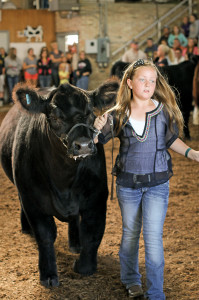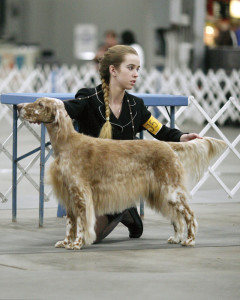Kids Who Show
Click here to read the complete article
You know them in the horse show arena, but you can find these kids competing with other four-legged friends.
By Lindsay Whelchel
 By the end of May, 12 year-old Sydnie Ochs will be hard at work bringing her animals indoors to stall in giant “coolers.” She will bathe the creatures and blow-dry their fluffy hair to an unimaginable height. The rest of her time will be spent mucking out the animals’ stalls, lest a speck of dirt or spot of manure mar their impeccably groomed coats.
By the end of May, 12 year-old Sydnie Ochs will be hard at work bringing her animals indoors to stall in giant “coolers.” She will bathe the creatures and blow-dry their fluffy hair to an unimaginable height. The rest of her time will be spent mucking out the animals’ stalls, lest a speck of dirt or spot of manure mar their impeccably groomed coats.
It’s all for show, but the animals she plans to compete with aren’t of the four-legged equine variety… In addition to competing on the AQHA show circuit, Ochs shows cattle as well as sheep and pigs. Many young equine competitors, like Ochs, have found a second home in the show arena with an array of livestock, dogs, and even more unexpected animals.
For Ochs, who hails from Wisconsin, showing is in her blood. Her mother and grandmother showed horses, and now she competes in all-around events like Showmanship, Trail, and Ranch Horse Pleasure. Her family also raises approximately 400 head of beef cattle, so it was only natural when she began competing with other animals at the county 4-H Fair.
“With horses, you want them to lose hair. With cattle, you want them to grow hair,” Ochs says of one big difference between showing horses and cattle. The hair-growing goal explains the giant coolers the cattle are kept in during the summer season. Many evenings at the Ochs’ household are spent practicing showmanship with the steer Ochs calls a “big teddy bear.”
“We also get pigs at the end of April and the same with lambs,” she says. “For pigs, you have to clean their pens, which you do a lot because they’re messy! Then, you’ve got to teach them how to walk. You usually take them outside and practice [holding] their heads up [high]. With sheep, you’ve got to teach them how to brace and shear them and teach them how to lead without a halter.”
Just like when showing horses, her time spent in the livestock pen has taught Ochs the value of responsibility, hard work, and dedication. “What you put in is what you get out of it,” she says. “The harder you work, the better you do.”
Another young horsewoman who has seen similar benefits from showing livestock, specifically pigs, is 18 year-old Shyanne Smith. With a halter horse trainer for a father, there was no doubt Smith too would develop her own career in the equine industry, competing in Halter as a youth and later transitioning to riding events under the guidance of trainer Robin Frid. Soon, Smith will join the Baylor University Equestrian Team when she heads to college in the fall.
Smith’s brother, Cooper, persuaded her to give pigs a try, when she was just nine years-old. “I fell in love, just like I did with the horses,” she says. “When pigs are 45 days-old and weaned off their mother, they go into a nursery, which is just a smaller pen. When you go to the breeding farm, there can be anywhere from 2,000 to 20,000 piglets. You just have to walk through and pick which one you think is the best.”
The baby pigs are so small they can fit in the palm of your hand, Smith says, acknowledging that the decision-making process when selecting a prospect is based largely on genetics.
Unlike in the horse world, livestock competitors aren’t allowed to have trainers. They can receive guidance from their school’s Agricultural Education teacher, but they must hone their skills and excel all on their own.
“You’re not allowed to pay anyone to take care of your animal. It’s strictly you, which teaches responsibility and leadership. That’s a big goal of the FFA [Future Farmers of America].”
Teaching a pig how to execute a show pattern isn’t too different from teaching a horse; repetition and practice is key when competing with any animal. However, Smith says there are a few key differences.
After going through the painstaking process of teaching a pig how to maneuver through a show pattern without a lead and only the guidance of a whip used for pointing, Smith has learned to develop patience and understanding.
“I’ve learned how to slow down and take everything step by step,” she says. “Life is too short to just rush through it and get angry and lose my patience. It’s taught me a lot about just slowing down and enjoying the little things, because [life] can go by fast,” specifically referring to the brief time she will get to spend with her show pigs.
For Smith, one of the most difficult parts of competing with livestock is having to let them go to sale at the end of the stock show. Smith explains that while this part is hard, it has taught her not just about the circle of life, but also about its preciousness and brevity.
Like show horses, nutrition and conditioning programs for show pigs are purposeful and routine. “You feed them protein, fats, and carbohydrates, just like the horses, and you work them similar to the horses,” she says. “They get worked twice a day. The rest of the time, they stay in and eat, and they’re on a schedule, just like horses.”
Another big difference between competing with horses and other livestock is the relatively short amount of time a competitor has to prepare with an animal before entering the ring. “Most of these kids, who’ve had their horses ever since they were in novice, are now going to World Shows and winning on these horses that are 20 years- old. When you show a pig, you only have them for a couple of months, and you have to get them broke in that amount of time before you can go anywhere and show and win with them.”
All of this hard work is paying off for Smith who has won past championships and was invited this year to compete in the National Western Stock Show in Denver, Colorado.
15-year-old Cameron Crenwelge shows market lambs and is familiar with being crowned a champion herself. Like Smith and Ochs, the process has instilled deeper meaning beyond simply winning a ribbon.
“I just love showing; there’s no place like the show ring,” Crenwelge says. This young competitor shows in equine classes like Showmanship and Equitation and has shown lambs at every major stock show in Texas. Most recently, she won Grand Champion at the Texas State Fair. “[Showing animals] has taught me how to win and lose with grace and how to work hard. It taught me how to really work for what I want.”
Crenwelge’s father showed lambs during his youth, so she was only too happy to carry on with the family tradition. Her school doesn’t have an active FFA chapter, so Crenwelge competes with her local 4-H team.
Crenwelge explains that showing lambs could be compared to showing horses in Halter, except that the exhibitor has to teach the lambs how to flex their muscles in a much different way. “It’s taken me years just to be where I am today as a showman with lambs, because each lamb is different. Each lamb has flaws, and you have to learn how to hide those flaws so you can win,” Crenwelge says.
While it’s certainly a competitive world, Crenwelge enjoys the friendly atmosphere at livestock competitions. “At lamb shows, you kind of create little friendly rivalries between families,” she says. “It’s all amicable, of course. It’s more like just having fun, whereas showing horses can get a little more serious.”
“At horse shows, trainers [and their clients] are separated by barns, and clients are separated by their trainers,” she says. “At lamb shows, since there are no trainers, everyone just hangs out. Most of the stock show kids help each other with their homework. You really know all of the people in your county. Everyone kind of helps each other out; it’s a pretty laidback atmosphere.”
 On the other end of the spectrum from showing livestock is Michelle McDowell, who grew up showing dogs. Her mother is a professional dog handler and while McDowell currently competes on the AQHA circuit and has shown other farm animals in 4-H, dogs have always been a part of her world.
On the other end of the spectrum from showing livestock is Michelle McDowell, who grew up showing dogs. Her mother is a professional dog handler and while McDowell currently competes on the AQHA circuit and has shown other farm animals in 4-H, dogs have always been a part of her world.
“Even when I was little, my mom set my playpen outside the dog show ring, so I’ve always gone to dog shows,” McDowell laughs. Nowadays, she doesn’t get to show dogs as much since she’s attending college at Grand Valley State University and is on the school’s equestrian team. Still, she explains that many people who show dogs also show or at least own horses, so it’s a relatively small world.
When competing with canines, exhibitors are aiming to win championships based on a dog’s conformation and movement. In the horse show world, McDowell says the competition atmosphere most closely mirrors Showmanship.
The biggest lesson McDowell has learned, as a competitor, has been good sportsmanship. “As with anything competitive, some days you win, and some days you lose. You’re going to have to know how to be a good sport, cheer other competitors on, and just be gracious whatever the outcome is.”
As it turns out, for these kids, when it comes to the benefits derived from showing animals, it doesn’t matter which species is in the ring with you after all.










